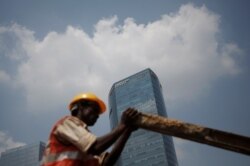Tens of thousands of migrants from India's countryside poured into the city of Gurugram as gleaming chrome and glass office buildings, high-rise apartments and upmarket shopping malls transformed the sleepy farming village on New Delhi’s outskirts into a booming business district over the last 15 years.
Huge construction projects and busy factories made it easy to find steady work in the city whose rapid growth coincided with a decade-long economic boom that lifted 270 million people out of poverty between 2006 and 2016.
Among them was 27-year old Javed Khan, who arrived more than a decade ago. As he searched for work, his first stop was a city intersection where day laborers gather to wait for contractors to pick them up. “When I first came here, I earned a decent wage,” he said. “Work went very well.”
But these days, he grows despondent as the wait at the same intersection becomes longer and longer. Khan said work has been hard to come by in the last year. “One-thousand of us collect here daily. Only 30 or 40 get picked up. The rest of us slowly go home.”
The swelling numbers of those searching for work is not surprising. Not many new buildings are going up as economic growth plummets to its lowest rate in a decade — from 8% four years ago to a projected 5% in the fiscal year that ends in March.
The slowdown in the construction sector, the second biggest employment provider after agriculture, is the most visible sign of India’s sputtering economy. It is a huge blow for millions of people who depend on daily wage work in cities to support themselves and their families back in villages. Rural areas depend heavily on remittances from migrant construction laborers.
Adarsh Kumar, 21, arrived in Gurugram three years ago. He said for two years he earned enough to send money to his parents, but now he can barely pay for his own room and board. “You work for 10 days and you sit idle for 20 days managing on that money.”
Low-income workers are not the only ones who have been badly hit in India’s struggling construction sector.
At the height of the economic boom, tens of thousands of homebuyers invested in housing projects in Noida, another fast-growing neighborhood in New Delhi’s vicinity. Now, partially constructed buildings dot the skyline as a credit crunch cripples developers and stalls hundreds of projects.
It is a huge blow for middle-class families. Some have seen their savings erode while others are stuck paying mortgages for unfinished homes.
Alpana Majumdar invested nearly $50,000 in an apartment in Noida that was to be completed five years ago, and for which she is still waiting to take possession of. “We were thinking if we get that house, we can give it on rent and I can earn some money from there,” she said.
With less money in their pockets, an aspirational middle class is buying fewer goods like cars and refrigerators — a hard blow to a country whose economy is largely powered by the money spent by its burgeoning middle class.
Auto showrooms are facing their slowest demand in 20 years while small shops cope with dropping sales as daily wage workers struggle to eke out a living.
The other big employment provider, factories and exporting units located in Gurugram’s industrial hub, are not faring much better. Exports have declined for six months in a row.
Kumar was among those who drew a blank in his search for work in export factories. “There are no vacancies anywhere. Even companies are not hiring.”
Economist N.R. Bhanumurthy at New Delhi’s National Institute of Finance and Policy said the slowdown is now in a “full-blown phase.”“
There is a decline in the demand from the external sector, from the household sector and from the private sector,” Bhanumurthy said. “Given this kind of slowdown across the sectors of the economy, that is why we are seeing a very sharp slowdown in the overall growth.”
The government has announced a series of measures to boost exports and manufacturing, as well as revive the housing sector, including a fund of nearly $1.5 billion to complete unfinished housing projects. It has cut taxes for the middle class in a bid to spur consumer spending.
While such steps may lead to a nascent recovery, economists do not expect a significant rebound.
They said it will be difficult for Prime Minister Narendra Modi to meet his goal of propelling India into a $5 trillion economy by 2025 or providing jobs for the millions entering a work force in a country where two-thirds of the population is under 35.
Both targets would require India to grow at more than 8% a year, and there are no signs of such a dramatic pickup on the horizon.
“When this $5 trillion target was fixed we were not sure it was based on any analysis,” said Bhanumurthy. “It maybe (was) a wishful kind of target.”
It has been a steep fall for India, which, until a year ago, was the world’s fastest growing major economy with a plunging poverty rate.
Those searching for work in Gurugram said times are the hardest in recent memory. “I have to pay $70 for a room, then I have to buy rations daily. If I don’t earn, how will I afford anything?” a woman named Reshma asked as she waited at the city intersection. Her eyes remained fixed on the road as she hoped that a builder who needed an extra pair of hands would stop.










